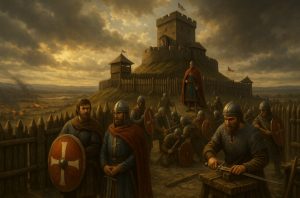What caused the fearsome Viking warriors to abandon their Scandinavian homelands and cross treacherous seas to raid and eventually settle in Britain? Why did the Viking Age, a period marked by violent raids and cultural transformations, begin in such dramatic fashion on the shores of Anglo-Saxon England?
The answer lies in a combination of environmental, political, economic, and ideological factors. These included the promise of wealth, the fragmentation of Anglo-Saxon kingdoms, climate pressures in Scandinavia, and a unique religious belief system that glorified battle.
Over time, what began as seasonal plundering evolved into full-scale invasions, permanent settlements, and the eventual transformation of Britain’s political and cultural landscape.
To understand why the Vikings invaded Britain, it is essential to explore what life was like both in Scandinavia and the British Isles before their arrival, and to follow the timeline of how raiding gave way to conquest and rule.
What Was Life Like in Britain Before the Viking Raids?

In the late eighth century, there was no unified country known as England. Instead, the region consisted of several competing Anglo-Saxon kingdoms, each ruled by its own monarch and populated by distinct groups of people.
The four most prominent kingdoms were Wessex, Mercia, Northumbria, and East Anglia. Each had its own political structure, economy, and military force. This decentralised landscape left Britain particularly vulnerable to external threats.
Monasteries were at the heart of Anglo-Saxon communities. These religious centres were not only places of worship but also of education, art, and wealth accumulation.
Ornate manuscripts, golden relics, and finely crafted religious objects adorned their halls. However, these treasures were largely undefended, making them highly attractive targets for seafaring raiders.
It’s important to note that peaceful interactions between Anglo-Saxons and Scandinavians existed before the Viking attacks began.
Trade routes connected the two regions, and there are historical accounts of cultural similarities, including shared styles in grooming and clothing. Nevertheless, the promise of unprotected wealth eventually overwhelmed any early peaceful relations.
When Did the Viking Raids on Britain Begin?
The Viking Age in Britain began with a brutal assault that has echoed through history. In June 793, the monastery of Lindisfarne, located off the northeast coast of Northumbria, was attacked by Viking raiders arriving in sleek, narrow longships.
The monks, taken by surprise, were slaughtered or enslaved, and the holy site was looted of its treasures.
The Anglo-Saxon Chronicle describes this event with vivid imagery, including lightning storms and omens of doom, portraying it as a catastrophic moment for Christian England.
This initial raid marked the beginning of what would become a widespread and enduring pattern of Viking activity.
While Lindisfarne is the most well-known target, it was by no means the only one. The following years saw similar attacks on other coastal monasteries, including Monkwearmouth-Jarrow and Iona in Scotland.
The effectiveness of Viking raids lay in their surprise and mobility. Their longships could travel across open seas and navigate inland rivers.
These vessels enabled rapid, unexpected attacks and swift escapes, making it difficult for local forces to respond in time.
Why Did the Vikings Initially Choose to Raid Monasteries?

Monasteries were chosen not because of their religious significance, but because they were among the wealthiest and least defended institutions in Britain.
Filled with gold, silver, illuminated manuscripts, and ornate religious artefacts, these sites represented substantial, concentrated wealth the very type of “movable wealth” the Vikings sought.
These monastic centres were often located on coasts or near rivers, making them easily accessible by ship. Their isolation from military strongholds and the non-combatant nature of their inhabitants further added to their vulnerability.
Viking warriors were not solely driven by greed. Their belief system also contributed to the justification of violence. Norse mythology glorified those who died honourably in battle, promising them a place in Valhalla, Odin’s great hall.
This spiritual reward encouraged aggressive pursuits abroad, where killing those outside of their own religion or kinship group was not considered dishonourable.
How Did the Viking Raids Evolve Into Invasions?
In the early years, raids were seasonal. Viking warriors would arrive in summer, plunder, and return home for winter.
But the successes of these missions inspired more ambitious efforts. Over time, the scale of attacks grew, culminating in the arrival of the Great Heathen Army in 865.
Led by the legendary Viking leaders Halfdan and Ivar the Boneless, this formidable force landed in East Anglia and began a systematic conquest of the Anglo-Saxon kingdoms.
Within six years, the army had overrun Northumbria, Mercia, and East Anglia, either killing their kings or forcing them into exile.
Viking control was not limited to battlefield dominance. Massive encampments were established in places like Lincolnshire, Yorkshire, and Staffordshire, some of which evolved into permanent towns. The Vikings brought their families and established new communities, shifting from raiders to settlers.
Why Did Wessex Resist While Other Kingdoms Fell?

Wessex, under the leadership of King Alfred the Great, became the only Anglo-Saxon kingdom that successfully resisted Viking domination.
Following a period of intense conflict, Alfred achieved a decisive victory over the Viking leader Guthrum at the Battle of Edington in 878.
Rather than pursue a continued military campaign, Alfred negotiated a peace agreement that led to the creation of the Danelaw a large portion of eastern and northern England where Norse laws and customs would prevail.
The remainder of southern and western England remained under Anglo-Saxon control, with Wessex at its centre.
This pragmatic division laid the foundation for future unification. Alfred also initiated military, educational, and legal reforms that strengthened his kingdom and improved its resilience against future invasions.
What Was the Danelaw and How Did It Affect British Society?
The Danelaw referred to the region of England ruled by the Vikings following the agreement between Alfred and Guthrum.
It included major areas like York (Jorvik), which became thriving Norse-ruled cities, blending Scandinavian and Anglo-Saxon cultures.
This period introduced significant cultural changes:
- Language: Many modern English words including sky, egg, window, and husband, originated from Old Norse.
- Place Names: Towns ending in “-by”, “-thorp”, or “-toft” (e.g., Grimsby, Scunthorpe) reflect Viking influence.
- Urban Development: Archaeological evidence from places like York shows densely populated trading hubs, skilled craftspeople, and connections to wider European markets.
Viking settlers influenced local governance, trade, and daily life, and their legacy remains especially strong in northern England.
When Was England Finally United Under One Rule?
After Alfred’s death in 899, his successors continued the struggle to unify England. His son, Edward the Elder, and daughter-in-law, Æthelflæd, Lady of the Mercians, pushed the Vikings back.
Their son, Athelstan, is credited with finally uniting England in 927, becoming the first king to rule all English territories under a single crown.
However, Viking ambitions did not end. In 1013, the Danish king Svein Forkbeard invaded and took the English throne.
After his death, his son Cnut reasserted control in 1016, forming a North Sea Empire that included England, Denmark, and Norway.
The Cnut dynasty, including his sons Harald and Harthacnut, ruled England until 1042. Even after their rule ended, Scandinavian influence remained strong in art, religion, and governance.
How Did the Viking Era in England Come to an End?

The last major Viking invasion occurred in 1066, led by Harald Hardrada of Norway. His forces were defeated at the Battle of Stamford Bridge by Harold Godwinson, the Anglo-Saxon king. However, just weeks later, Harold was defeated by William of Normandy at the Battle of Hastings.
With the Norman Conquest, the Viking Age effectively ended, although Norse customs and culture lingered for generations, especially in areas that were once part of the Danelaw.
What Is the Lasting Legacy of the Vikings in Britain?
The Viking legacy in Britain is broad and deep, influencing language, law, art, and identity. Though often remembered as brutal raiders, the Vikings also contributed to the creation of a unified English nation.
Their settlements laid the foundation for urban growth, their language enriched English vocabulary, and their challenge to Anglo-Saxon dominance ultimately forced political consolidation.
Perhaps the most significant legacy, however, is the transformation they triggered. By invading, conquering, and settling, the Vikings initiated a chain of events that ended the era of separate Anglo-Saxon kingdoms and brought about the birth of England as a single, unified realm.
Frequently Asked Questions
Were Viking attacks always violent?
Not always. While many early raids involved looting and violence, later expeditions were more focused on settlement and trade. As time passed, Vikings increasingly integrated into local communities.
How do we know about Viking activity in Britain?
Much of what we know comes from the Anglo-Saxon Chronicle, historical sagas, and archaeological discoveries, including weapons, jewellery, and town layouts in places like York and Lincolnshire.
What was the role of Viking religion in the invasions?
Norse beliefs glorified bravery and warfare. Warriors who died in battle were believed to be rewarded in Valhalla. This ideology encouraged raiding and conquest.
Did Viking rule change British laws?
Yes. In areas under Viking control, Norse legal customs blended with Anglo-Saxon laws. These influences persisted even after the Viking era ended.
Were Viking leaders like Cnut considered legitimate English kings?
Yes. Cnut ruled effectively and is often regarded as one of England’s better kings. He maintained peace, respected Anglo-Saxon traditions, and expanded England’s reach.
Why did Viking raids stop?
Over time, Scandinavia itself became more centralised and Christianised. Raiding lost its cultural appeal, and economic focus shifted to trade. Military losses, like at Stamford Bridge, also marked the end of Viking dominance.
What remains today of Viking culture in Britain?
From place names and linguistic contributions to archaeological sites and museum collections, the Viking legacy remains visible, especially in the north and east of England.






